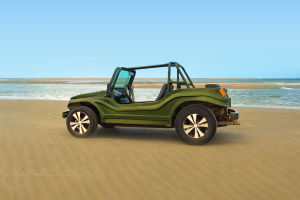For outdoor riding enthusiasts, do you know how to ride a dirt bike?
Let's get some professional knowledge: beginners should have a hydraulic disc brake in the front to easily lock the front wheel, as it's difficult to lock the front wheel without it.
Once skilled, a drum brake in the front will be fine. However, it's crucial to understand that locking the front wheel is dangerous. The most appropriate way to use the brakes is without locking the wheel. Let's get into the details and learn dirt bike riding skills!
1. Lifting the Front Wheel
Lifting the front wheel is one of the most basic skills in dirt bike riding. You can think of it this way: if you can't lift the front wheel, you're not yet into the world of dirt bike riding. While this might not be scientifically correct, many people view it this way. Mastering this skill is critical for enthusiasts. It's not about impressing others but understanding how much it helps with real riding. This skill is essential for overcoming obstacles such as ditches, rocks, steps, and logs.
There are two methods to lift the front wheel: using the body and throttle together, or using the clutch.
• Using the body and throttle together: First, maintain balance and control your speed. Then, lean your body forward so that the front suspension compresses. After that, quickly move your body weight backward while using the rebound force from the suspension to lift the handlebars. Increase the throttle appropriately, and the front wheel will lift.
• Using the clutch: Similarly, maintain balance and control your speed. Squeeze the clutch lever, add a little throttle to keep the engine RPM at an appropriate range, and then quickly release the clutch. The front wheel will naturally lift due to the rear wheel's driving force.
2. Lifting the Rear Wheel
Lifting the rear wheel is just as basic as lifting the front wheel, but it's easier to master. While its role in performance is unique, the exact benefits beyond showmanship are still unclear. For now, let's focus on how to perform this skill.
The best place to practice lifting the rear wheel is on surfaces with high friction, such as asphalt. The second-best surface is synthetic tracks, and the least suitable is concrete. It's best not to practice on other types of terrain unless you have enough experience.
Before lifting the rear wheel, ensure the bike is at a steady speed and moving in a straight line. Keep your knees tight against the bike to maintain unity between you and the bike. Hold the front brake tightly to lock the front wheel. Grip the handlebars firmly, lean forward, and move your body weight forward. The bike will lift the rear wheel due to inertia, the compression of the front suspension, and your body's coordination.
3. Turning in Place
The in-place turning technique is essentially the same as turning with throttle acceleration, but it involves a much larger turning angle, potentially 360 degrees or more.
To perform this technique:
• Use a lower gear and pull the clutch lever.
• Lean the bike naturally to one side using its own weight.
• Extend one foot in the direction of the turn, and turn the handlebars accordingly.
• Keep the other foot on the footpeg, press your knees against the bike, and tilt your body outward. When the bike tilts at a sufficient angle, quickly increase the throttle and release the clutch lever. The rear wheel will start to rotate around the foot in the direction of the turn. The turning angle can be adjusted depending on your physical strength.
4. Jumping
Jumping is a common action in races, and its potential for skill development is significant. However, it's important to note that the highest jumper isn't always the fastest rider.
When preparing for a jump:
• As you approach the takeoff point, adopt a semi-standing position.
• Maintain moderate acceleration. If you go too fast, it can become dangerous.
• At the optimal takeoff point, increase the throttle and pull the handlebars toward you. This will launch both you and the bike into the air.
• In mid-air, keep your knees tight against the bike, release the throttle to return to its original position, and shift your body forward. Stay relaxed and ready to absorb the impact when landing.
• Land with the rear wheel first, followed by the front wheel. This ensures the force of the landing is absorbed evenly by both wheels, preventing the bike from losing balance. Avoid letting the front wheel land first or without absorbing the impact.
5. Crossing Deep Ditches
• Body Weight Distribution: When entering this section, ensure your body weight is concentrated on the footpeg on the outside of the bike. This will help maintain balance and follow the correct line.
• Keep Your Elbows High: Raising your elbows allows for better control of the handlebars.
• Look Ahead: Once you enter the ditch, if you follow the previous steps correctly, you shouldn't fall or lose control. Keep your eyes on the path ahead to prepare for any obstacles.
• Throttle Control: Maintain a consistent throttle during the ditch section. If you reduce throttle too much, the rhythm will be disrupted.
6. High-Speed Rolling Peaks
The key to navigating rolling peaks at high speeds is posture. These peaks are usually gentle but can occur in a sequence. If your posture isn't correct, you might find yourself struggling after a few.
• Leg and Footwork: Keep your feet inward and legs tight against the bike to absorb the shock and prevent excessive forward or backward motion.
• Avoid Braking: On these sections, don't use the brakes unless necessary. If you feel you're going too far, reduce the throttle slightly. Reducing throttle will prevent you from losing control in mid-air.
• Takeoff and Landing: After taking off, focus on keeping the rear wheel landing first. Immediately increase the throttle and shift your body weight backward. If the next peak is too steep, aim to land both wheels at the same time.
7. High-Speed Downhill Riding
• Braking: Select the appropriate line for the downhill section and apply consistent brake pressure. Control the braking distance before entering turns to maintain the highest possible speed and set yourself up for the turn.
• Rear Brake: Keep the rear brake engaged throughout the downhill, ensuring the rear wheel doesn't bounce, while maintaining effective traction.
• Front Brake: Use the front brake minimally to avoid affecting the bike's direction. Excessive front braking could lead to steering instability.
• Gear Selection: It's not necessary to use engine braking. Keep the gear at a higher range and downshift when approaching turns.
• Posture: Keep your body weight centered and elbows in an aggressive stance to absorb unexpected impacts. Also, ensure your knees stay tight against the bike to prevent being bounced off.
8. Crossing Washboard Roads
Washboard roads, with their continuous bumps, are some of the most difficult terrains to navigate. But with proper practice, you can cross them quickly and safely.
• Gear Up: Switch to a higher gear to improve suspension function.
• Shift Your Weight Back: Stand up and maintain an attack position with your weight shifted toward the rear fender.
• Knee Grip: Use your knees to firmly grip the bike, preventing side-to-side wobbling for better control.
• Footwork: Apply pressure on the balls of your feet, keeping your feet parallel to each other to avoid injury from sudden impacts.
• Upper Body: Keep your shoulders level and firmly grip the handlebars, always ready to absorb ground shocks.
• Clutch Control: Keep one finger on the clutch to quickly adjust the throttle for bursts of acceleration.
• Head Position: Keep your head up and eyes focused on the road ahead to react promptly to any changes.
9. Crossing Sand Turns
Although the outside line in large sandy turns is typically not the fastest, it is often the best option. Here's how to cross sandy turns effectively.
• Body Position: Keep your body centered over the bike. Avoid shifting your weight too far forward, as the front wheel can sink into the sand.
• Throttle Control: Maintain steady throttle input throughout the turn. Avoid reducing or increasing throttle suddenly to prevent losing speed or control.
• Clutch Control: Use one finger on the clutch to fine-tune your RPM. If the turn becomes too soft, adjust the RPM to keep your momentum.
• Weight Distribution: Shift your weight to the outside footpeg to maintain balance while turning.


